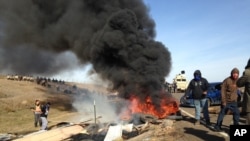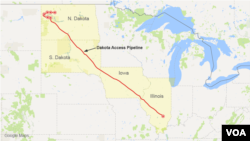Police have removed more than 100 protesters from private land in the midwestern state of North Dakota. The protesters were showing their opposition to an oil pipeline in a demonstration that turned violent.
An official with the Morton County Sheriff’s Department told the Associated Press 141 people were arrested Thursday.
Police officers used pepper spray to break up a camp of protesters. Among those arrested was one person who had fired three shots at police. No serious injuries were reported. One man was treated for a leg injury, according to the AP.
Sheriff Kyle Kirchmeier said protesters were given a final warning Wednesday to leave the private land, but they did not go.
Protests by Native Americans and their supporters have been held in the area since July. The demonstrators oppose the building of the Dakota Access pipeline.
Much of the 1,700-kilometer pipeline is nearly complete. When finished, it would transport about 400,000 barrels of oil a day from North Dakota to Illinois. From Illinois, other pipelines could then transport the supply to shipping ports and refineries across the United States.
The pipeline’s path comes within one kilometer of land belonging to American Indians from the Standing Rock Sioux tribe.
The tribe has said the pipeline, which would be buried under the nearby Missouri River, could endanger its water supply. It also believes construction could destroy sacred Native American historical sites.
The movement supporting the tribe’s position has expanded to include environmental groups. Supporters include Green Party presidential candidate Jill Stein, civil-rights activist Jesse Jackson, Hollywood celebrities and U.S. Congress members.
Hundreds of protesters had gathered on nearby U.S. government-owned land to hold demonstrations. Others have been arrested since those protests began in July.
But this week, the protesters occupied land owned by Energy Transfer Partners, which leads construction of the pipeline. The company has rejected the protesters’ arguments and says the project meets all legal requirements.
Supporters of the project say the pipeline is a safer and more cost-effective method than using roads or railways to move the oil.
The tribe brought a legal case in court to dispute the approval of permits by the U.S. Army Corps of Engineers for construction on federal land. A federal judge denied a request in September to halt the project.
But three federal agencies took action to stop construction on land owned by the Army Corps of Engineers. The Corps is currently deciding whether to reconsider the environmental impact of the pipeline. This would stop construction for a longer period.
A spokesman for the protesters said the latest police action will not silence the movement. He said they plan to build a new camp at another location in the pipeline's path - but this time on federal land.
I’m Bryan Lynn.
Bryan Lynn wrote this story for VOA Learning English. Additional material came from VOA News, the Associated Press, Reuters and Agence France-Presse. Mario Ritter was the editor.
We want to hear from you. Do you think the government should keep blocking construction of this pipeline? Write to us in the Comments section, and visit our Facebook page.
________________________________________________________________
Words in This Story
pepper spray – n. substance made from peppers that causes irritation to the eyes, nose and skin when sprayed
barrel – n. a standard measure for oil that is equal to about 159 liters
refinery – n. factory where substances such as oil are made pure
sacred – adj. relating to religion or consider holy
permit – n. written document or license granting authority
impact – n. effect of a situation or thing on something else












